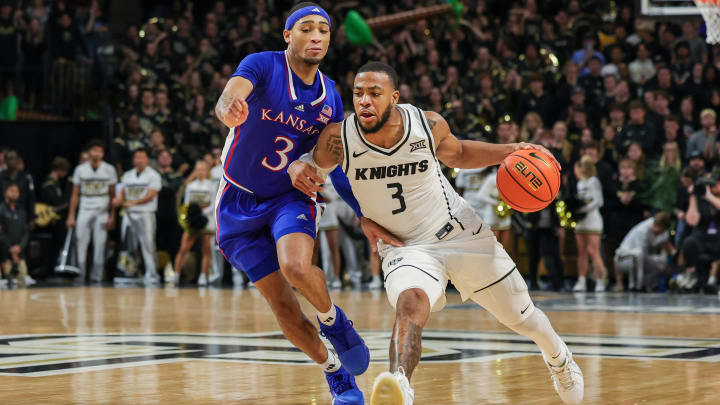Road Wins Should be Worth More in Men’s College Basketball

In this story:
The top of the men’s college basketball landscape has been flipped on its head in the last 48 hours.
Four of the nation’s top five teams in the most recent AP poll lost in two days, all to unranked teams. Some of the upsets weren’t so surprising, like the Houston Cougars taking their first loss at Hilton Coliseum to the Iowa State Cyclones. Others, like the Kansas Jayhawks getting tripped up by a UCF Knights team fresh off a 25-point loss to the Kansas State Wildcats, were more shocking. In all, it made for a historic stretch of results. According to Fox Sports Research, it’s the first time in college basketball history that four top-five teams have lost in such a short period of time. And here’s the common thread that connects them: All four losses were road games for the ranked team.
It’s not news that it’s incredibly difficult to win on the road in men’s college basketball, particularly in conference play. But it has been even harder than usual this season: Per analytics expert Evan Miyakawa, home teams in the top seven conferences are winning 66% of the time in 2023–24, compared to around 61% in the past two seasons. These numbers, combined with the extremely visible upsets at the top of the national rankings, make now the perfect time for the NCAA tournament selection committee to double down on valuing road wins heavily in both selection and seeding.
How teams fare on the road is already a part of the selection process, namely through the quadrant system. For instance, a win on the road against a team ranked from No. 1 to No. 75 in the NET is a Quad 1 win, compared to just 1 to 30 at home and 1 to 50 on a neutral floor. Plus, road records themselves are listed on the official team sheets used by the committee to evaluate each squad. But the picture gets muddied quickly given how much information the committee says it considers, from an array of results-based and predictive metrics to records against each quadrant, strength of schedule and more. With how much elite teams are struggling in road games, in some cases against teams that won’t even make the NCAA tournament, it makes sense to use winning on the road as a separator for who gets to go dancing and who doesn’t.
Take last season’s bubble, for instance. The last four teams into the field (the Nevada Wolf Pack, Pittsburgh Panthers, Arizona State Sun Devils and Mississippi State Bulldogs) went .500 on the year combined in road games, and none advanced past the round of 32. Might we have had a more exciting start to the Big Dance had the four teams that reached the semifinals of the NIT (the North Texas Mean Green, UAB Blazers, Wisconsin Badgers and Utah Valley Wolverines) danced instead, with their combined road-winning percentage of nearly 63%? Over the last five NCAA tournaments played in years with traditional fan attendance (so excluding 2021), just one of 20 Final Four participants had a sub-.500 road record, with an average regular-season road winning percentage of a blistering 69% in that period. Teams that win on the road tend to win in March: Let’s reward them on Selection Sunday for doing so.
A heavier emphasis on road wins would also bring more equity to the selection process. Nonconference scheduling is heavily influenced by resources. The ability to buy home games against lower-level competition to inflate win-loss records and having access to top-tier, early-season tournaments have a huge impact on tournament selection and seeding. More incentive to play road games would give mid-majors that otherwise don’t have the same opportunities to build competitive résumés, and might even encourage high-majors that tend to avoid going on the road in nonconference play to occasionally test themselves by leaving home.
It’s hard to envision a downside here. At worst, a high-major or two might attempt to artificially inflate their road record by playing some of the worst teams in Division I on the road in nonconference play, giving rare opportunities for smaller programs to upset big brands. More realistically, it might encourage more true home-and-home series rather than the neutral-site games that have taken over nonconference scheduling in the last several years. And if that means the best early-season games get played in front of high-level atmospheres with students on campus rather than in stale, half-empty NBA arenas, all the better.
If even the nation’s elite are struggling to win on the road, let’s reward the teams that find a way to do it in March. Chances are, they’ll make the committee look smart once the ball tips off in the Big Dance.

Kevin Sweeney is a staff writer at Sports Illustrated covering college basketball and the NBA draft. He joined the SI staff in July 2021 and also serves host and analyst for The Field of 68. Sweeney is a Naismith Trophy voter and ia member of the U.S. Basketball Writers Association. He is a graduate of Northwestern University's Medill School of Journalism.
Follow CBB_Central